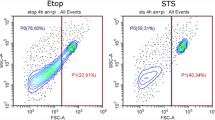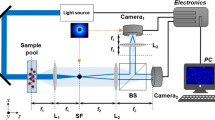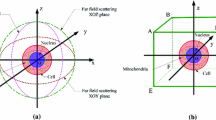Abstract
Light scattering properties of hybridoma cells were examined with flow cytometry. Viable and dead cells form two distinct populations. The distribution of the two populations changes during a batch culture. the concentration of dead cells measured by flow cytometry correlates well to that measured by hemacytometer. The distribution based on small-angle light scattering is similar to the distribution based on volume as measured by Elzone particle counter. It thus appears that viable cells form the population with a larger mean cell volume. The results also indicate that the volume of viable cells decreases during the cultivation while that of dead cells remains relatively constant.
Similar content being viewed by others
References
BrunstigA and MullaneyPF (1974) Differential light scattering from spherical mammalian cells. Biophys. J. 14: 439–453.
Frame KK and HU W-S: Cell volume measurement as an estimation of mammalian cell biomass. Biotechnol. Bioeng. (accepted for publication).
KrishanA (1975) Rapid flow cytofluorometric analysis of mammalian cell cycle by propidium iodide staining. J. Cell. Biol. 66: 188–193.
LearyJF, ToddP, WoodsUCS and JettJH (1979) Laser flow cytometric light scatter and fluorescence pulse rise-time sizing of mammalian cells. J. Histochem. Cytochem. 27: 315–320.
LokenMR, ParksDR and HerzenbergLA (1977) Identification of cell asymmetry and orientation by light scattering. J. Histochem. Cytochem. 25: 790–795.
LokenMR, StourRD and HerzenbergLA (1979) Lymphoid cell analysis and sorting. In Flow Cytometry and Sorting. MelamedMR, MullaneyPF, MendelsohnML Eds., John Wiley and Sons, NY, p. 505–528.
MuirheadKA, HoranPK and PosteG (1985) Flow cytometry: present and future. Biotechnology, 3: 337–355.
MullaneyPF, VanDillaMA, CoulterJR and DeanPN (1969) Cell sizing: a light scatter photometer for rapid volume determination. Rev. Sci. Instrum. 40: 1029.
SasakiDT, DumasSE and EnglemanEG (1987) Discrimination of viable and non-viable cells using propidium iodide in two color immunofluorescence. Cytometry 8: 413–420.
SteinkampJA (1984) Flow cytometry. Rev. Sci. Instrum. 55: 1375–1400.
TraganosF (1984) Flow cytometry: principles and applications. 1. Cancer Invest. 2: 149–163.
Author information
Authors and Affiliations
Rights and permissions
About this article
Cite this article
Sen, S., Srienc, F. & Hu, WS. Distinct volume distribution of viable and non-viable hybridoma cells: A flow cytometric study. Cytotechnology 2, 85–94 (1989). https://doi.org/10.1007/BF00386140
Received:
Accepted:
Issue Date:
DOI: https://doi.org/10.1007/BF00386140




